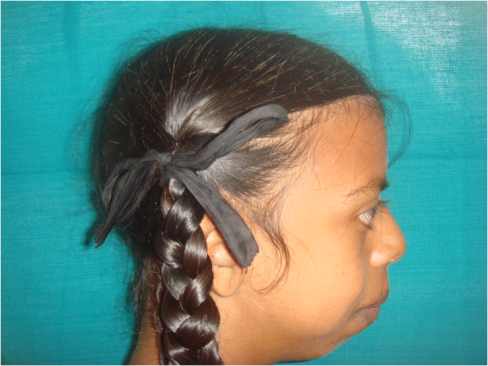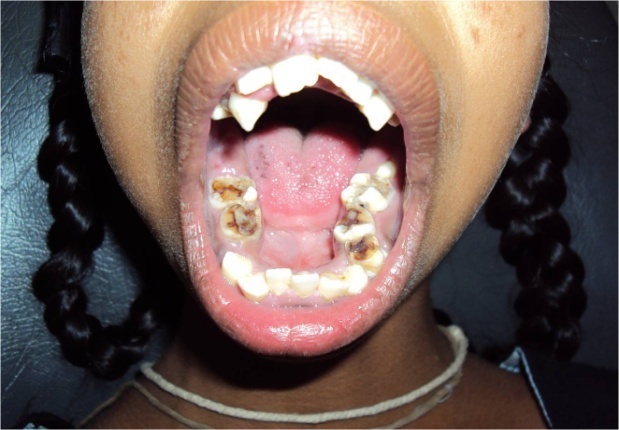-
Paper Information
- Paper Submission
-
Journal Information
- About This Journal
- Editorial Board
- Current Issue
- Archive
- Author Guidelines
- Contact Us
Clinical Practice
p-ISSN: 2326-1463 e-ISSN: 2326-1471
2014; 3(2): 11-13
doi:10.5923/j.cp.20140302.01
Lujan Fryns Syndrome - A Case Report
Amit Soni1, Ajita Meenawat2, Khyati Soni1, Vivek Srivastava3
1Dental surgeon, Brampton Ontario, Canada
2Assistant Professor, Department of Periodontics, BBD College of Dental Sciences, Lucknow, India
3Assistant Professor, Department of periodontics, Chandra Dental College & Hospital, Lucknow, India
Correspondence to: Amit Soni, Dental surgeon, Brampton Ontario, Canada.
| Email: |  |
Copyright © 2014 Scientific & Academic Publishing. All Rights Reserved.
Lujan Fryns syndrome is a condition characterized by intellectual disability, behavioral problems and certain physical features. It is an uncommon condition with unknown prevalence caused by atleast one mutation in the MED12 gene. We report a case which has been diagnosed with Lujan Fryns syndrome.
Keywords: Lujan fryns syndrome, Marfanoid habitus, Mental retardation
Cite this paper: Amit Soni, Ajita Meenawat, Khyati Soni, Vivek Srivastava, Lujan Fryns Syndrome - A Case Report, Clinical Practice, Vol. 3 No. 2, 2014, pp. 11-13. doi: 10.5923/j.cp.20140302.01.
1. Introduction
- Lujan Fryns Syndrome (LFS) or X-linked mental retardation with Marfanoid habitus and Lujan Syndrome is an X-linked genetic disorder that causes mild to moderate intellectual disability and featrures described as marfanoid habitus referring to a group of physical characteristics similar to Marfan syndrome. It includes a tall, thin stature, long and slender limbs with psycopathology and behavioral abnormalities exhibiting a number of malformations affecting the brain and heart. It is inherited as an X-linked dominant character attributing to a missense mutation of MED12 gene. There is currently no treatment for LFS or MED12 malfunction as the exact etiology remains unclear1. We report as case of LFS in a 12 year old female patient.
2. Case Report
- A 12 year old female patient reported to department of Oral Medicine & Radiology with the chief complaint of pain in the upper left back tooth region since one week. Pain was mild, intermittent and accompanied with swelling in the same region since 2 days. The swelling subsided gradually but the pain persisted. On general examination it was found that the patient was hypoasthenic with body weight of 25 kg, height was 137 cm, gray hairs, long extremeties and clinodactyly of fifth finger of both hands (Fig 1 & 2). On consultation with the parents it was found that there was partial impairment of sensory and motor functions of patient since birth. They consulted a local medical practitioner 7-8 years back who diagnosed mental retardation in the child and gave medication but there was no improvement. Further the patient is studying in 2nd standard since 3 years and was unable to clear the school examinations.
 | Figure 1 & 2. Showing the general body features related to Lujan Fryns syndrome |
 | Figure 3. Showing the convex profile |
 | Figure 4. Showing the dental abnormalities |
 | Figure 5. OPG showing impacted & mixed dentition |
3. Discussion
- Lujan syndrome are among the XLMR (X-Linked Mental Retardation) syndromes that present itself with great diagnostic challenge for medical/dental practitioners. Individual with this syndrome shows signs of tall stature with asthenic build, macricepahly, tall narrow face, maxillary hypoplasia, high narrow palate with dental crowding, a smaller receding chin, long hands with hypperextensible digits, hypernasal speech, hypotonia, mild to moderate mental retardation, behavioral abnormalities and agenesis/dysgenesis of corpus callosum [1]. The case presented here also had the same signs and symptoms. It has been suggested that muscle hypotrophy, hypotonia, developmental delay and shyness were more notable before puberty while marfanoid habitus, more specifically the excess of span overheight became obvious nly after puberty [1, 2]. There is no specific diagnostic test available for confirmation but to rule out, examination should include cardiac examination and ultrasound, ophthalmic examination, chromosomal analysis with special attention for chromosome 5pter & 22q11 and biochemical analysis of aminoacids in plasma and urine [2]. Cardiovascular defects like ventricular septal defect and aortic root dilatation have been reported in few cases [3], but this finding was not present in our case. Regarding chromosomal analysis it has been suggested that there is mutation in MED12 gene [4, 5]. The highly conserved MED12 protein also known as HOPA & TRAP230, is the largest component of the mediator complex which has an essential role in regulating RNA polymerase II activity. The mediator complex contains a large number of subunits, some core elements and others like MED12 that serve as transcriptional facilitators for specific pathways. The importance of MED12 gene is that it is essential for normal development of specific developmental pathways [6-8]. In our case also the pediatrician specified for the genetic analysis but the patient’s parents were not ready for further analytical support.There is no specific treatment for this condition. Patients should be monitored periodically to prevent severity of the condition. Cardiac problems or epileptic seizures should be monitored regularly with special attention on education and psychological follow up [9, 10]. The current management is palliative therapy and may involve special needs education, behavioral therapy and speech therapy. Research is currently focusing on gene therapy, protein replacement, transcriptional regulation, nutritional intervention, regulation of neurotransmission and mRNA based therapy [11-13].Folate therapy has been tried in the past in the hope that it would help to control inattention and aggressiveness in prepubertal males, but folate deficiency has never been demonstrated and the evidence base is equivocal. Atypical antipsychotics, serotonin reuptake inhibitors and anticonvulsants have all been found to be helpful in treating various aspects of abnormal behavior. The genetic counseling and support of the parents and other family members should not be forgotten [14].No specific treatment exists for the genetic causes of LFS. However, some measures can be taken to make the life of the person more comfortable. Attention to the heart defects and seizures or other life threatening conditions is essential. A variety of corrective, preventive and intervention therapies may be prescribed [15].
 Abstract
Abstract Reference
Reference Full-Text PDF
Full-Text PDF Full-text HTML
Full-text HTML